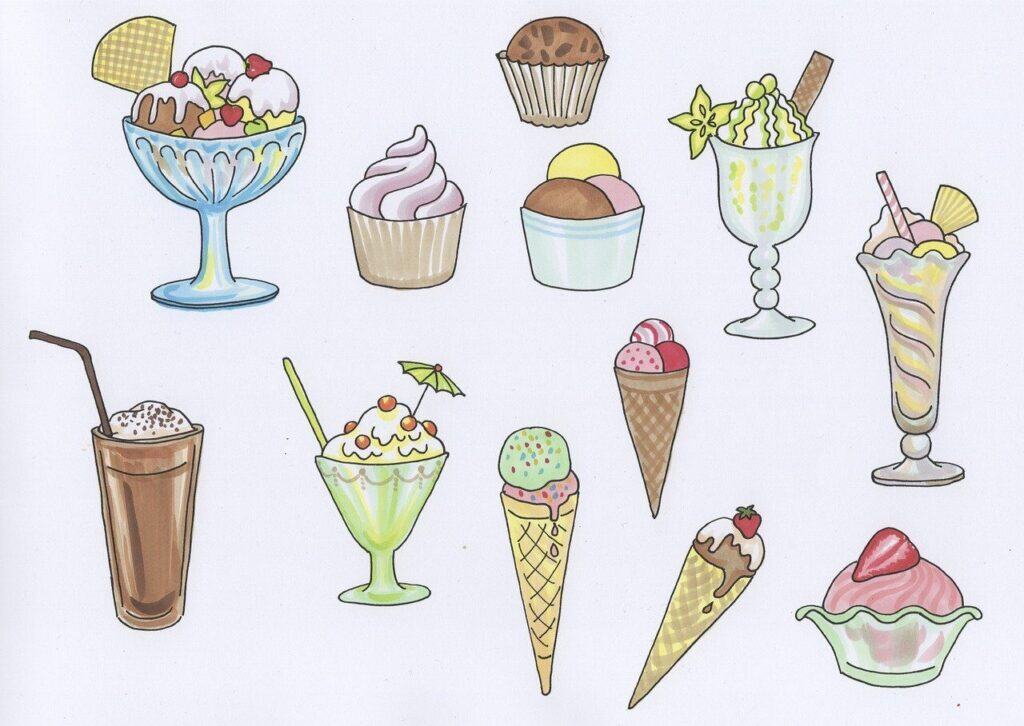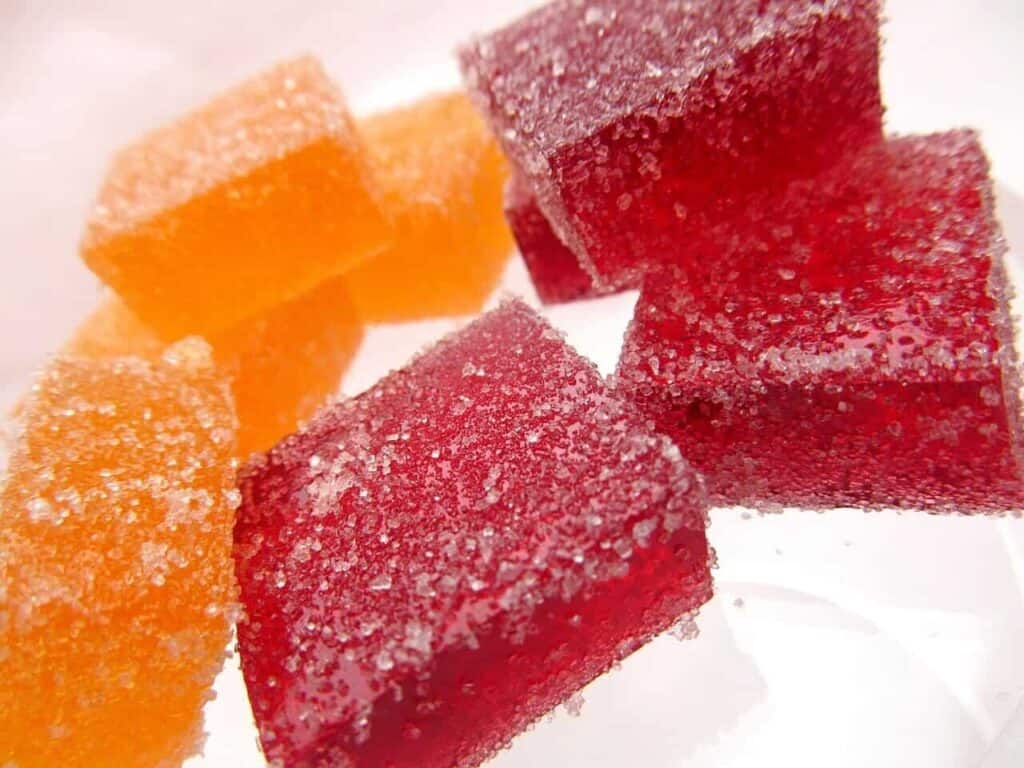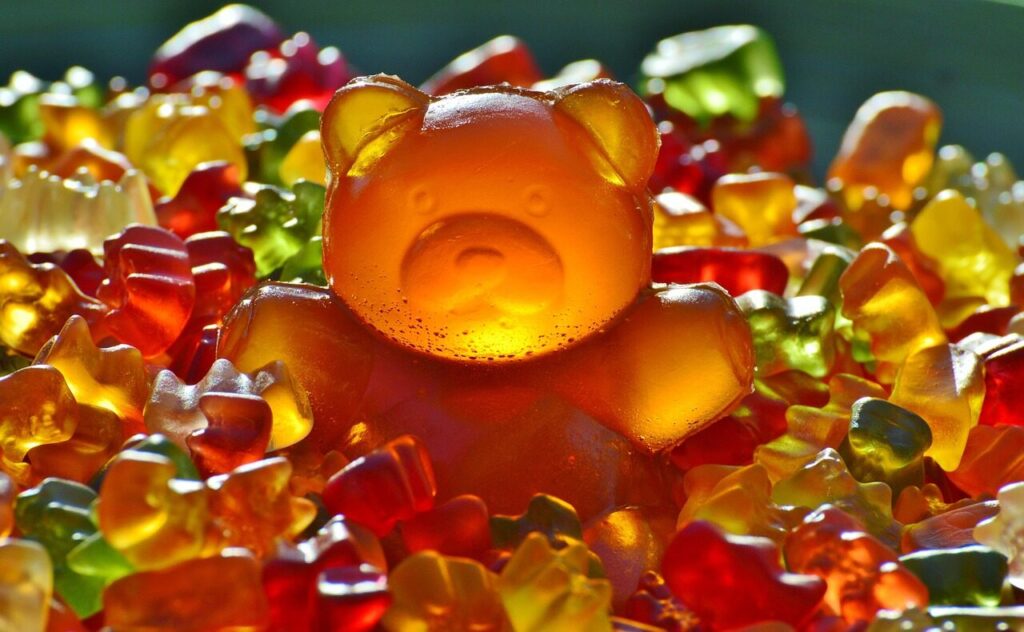La science sucrée des Snake Gummies : Une analyse technique de la texture et du goût
La gomme serpent est une icône universelle du bonbon. Sa couleur vive, sa forme de serpent et sa mastication satisfaisante sont gravées dans notre mémoire commune. C'est un plaisir simple et nostalgique.
Mais cette simplicité cache un monde de science alimentaire complexe et d'ingénierie minutieuse. Qu'est-ce qui donne au serpent gommeux sa texture unique ? Comment les fabricants parviennent-ils à produire des millions de pièces identiques présentant le mélange parfait de douceur, d'acidité et de saveur ?
Il ne s'agit pas d'une recette ou d'une critique de produit. Nous voulons vous donner une analyse technique approfondie. Nous analyserons la gomme serpentine du point de vue d'un scientifique de l'alimentation. Nous démonterons les processus complexes qui transforment quelques ingrédients simples en un chef-d'œuvre de la confiserie.
Nous irons du fonctionnement de chaque élément chimique au niveau moléculaire jusqu'à l'énorme processus de fabrication industrielle. Nous explorerons les principes physiques de sa mastication caractéristique et la science qui sous-tend notre goût. Nous découvrirons ainsi l'ingénierie cachée qui se cache derrière cette friandise bien-aimée.
Le schéma chimique
Pour comprendre le snake gummy, il faut d'abord comprendre de quoi il est fait. Chaque ingrédient est choisi non seulement pour son goût, mais aussi pour une fonction spécifique qui contrôle la structure finale et la stabilité du bonbon.
L'agent gélifiant
Le cœur de tout chewing-gum est son agent gélifiant. Traditionnellement, il s'agit de la gélatine. Elle provient du collagène animal. La gélatine est une protéine qui forme un réseau tridimensionnel complexe lorsqu'elle est mélangée à l'eau. Ce réseau retient l'eau et les autres ingrédients.
Cette matrice protéique crée directement la "mâche" classique et élastique. Elle donne également la texture lente et fondante qui caractérise les bonbons gélifiés de haute qualité.
Une mesure clé pour les fabricants de bonbons est la résistance au gonflement. Elle mesure le degré de rigidité et de fermeté du gel. Pour obtenir une gomme serpentine ferme et rebondissante, les fabricants utilisent généralement de la gélatine à haut pouvoir gonflant. Celle-ci se situe souvent entre 220 et 250. Ce gel est également thermoréversible. Cela signifie qu'elle peut être fondue et réinitialisée. Cette caractéristique est cruciale pour la production.
La matrice des édulcorants
Les gommes à mâcher utilisent rarement un seul type de sucre. La recette est un mélange soigneusement équilibré de différents édulcorants. Chacun d'entre eux a une fonction spécifique qui va au-delà du simple goût sucré.
Le saccharose, ou sucre de table courant, apporte le goût sucré principal et franc que les consommateurs attendent.
Le sirop de glucose est souvent appelé sirop de maïs en Amérique du Nord. Il sert d'"agent de raclage". Sa principale fonction est de contrôler la cristallisation du sucre. Il empêche les molécules de saccharose de former de gros cristaux. Cela permet d'éviter une texture granuleuse et désagréable. Il garantit que le produit final la gomme reste molleIl est transparent et se conserve facilement. Il ajoute également au corps et à la mastication de la gomme.
Le rapport exact entre le saccharose et le sirop de glucose est essentiel dans toute recette de bonbons gélifiés. Ce rapport affecte directement la texture finale, la perception du goût sucré et la stabilité à long terme du produit.
Acides : Saveur et fonction
Les acides jouent deux rôles vitaux et interdépendants dans la production des bonbons gélifiés. Ils sont essentiels à la fois pour l'expérience gustative et pour la structure chimique.
Le premier rôle est celui de la saveur. Les acides tels que l'acide citrique (présent dans les agrumes) et l'acide malique (présent dans les pommes) apportent l'acidité caractéristique. Ce "pop" contrebalance la douceur intense du mélange de sucre. Le profil de saveur global s'en trouve ainsi éclairci.
Le second rôle est d'ordre technique. L'ajout d'acide abaisse le pH du mélange gélifié. C'est essentiel pour maximiser la force du gel de la gélatine à haute teneur en oxygène. Pour une structure de gel et une fermeté finale optimales, le mélange est généralement ajusté à un pH cible de 3,4-3,6.
Arômes et colorants
La signature gustative finale d'un serpent la gomme provient de son goût et de sa couleur systèmes. Ils sont souvent ajoutés à la fin du processus de cuisson.
Ces composants doivent être stables à la chaleur. Ils sont généralement ajoutés à un mélange liquide chaud avant la dépose. Le choix d'arômes et de colorants naturels ou artificiels dépend du positionnement sur le marché et des exigences réglementaires.
L'histoire de deux gels
Tandis que Gélatine est l'épine dorsale traditionnelle du snake gummy, il existe une alternative principale : la pectine. Comprendre la différence entre ces deux gélifiants montre comment le choix d'un seul ingrédient peut complètement transformer le produit final.
Mâcher classique ou mordre court
La pectine est un polysaccharide d'origine végétale. Elle est généralement extraite des écorces d'agrumes ou du marc de pommes. C'est l'agent gélifiant par excellence pour créer des gommes végétaliennes et végétariennes.
La différence de texture est énorme. La gélatine donne une mastication souple, élastique et "longue". Elle s'étire lorsque vous tirez dessus. Elle fond lentement et proprement dans la bouche, libérant progressivement sa saveur.
La pectine crée une texture plus tendre mais "courte". Elle donne une rupture nette lorsqu'on la mord, un peu comme une gelée ferme, plutôt qu'une traction extensible. Cette structure de gel différente permet également une libération plus rapide et plus immédiate de la saveur. Il se décompose plus rapidement dans la bouche.
Fonctionnalité | Gélatine | Pectine |
Source | Animal (Collagène) | Plantes (principalement écorces d'agrumes, pommes) |
Profil de texture | Elastique, à mâcher, gommeux | Tendre, morsure courte, gélatineuse |
Point de fusion | Faible (fond à une température proche de celle du corps) | Élevé (ne fond pas dans la bouche) |
Définition des besoins | Temps et température | pH spécifique et concentration en sucre |
Régime alimentaire | Non végétalien/végétarien | Convient aux végétaliens et aux végétariens |
Le choix entre la gélatine et la pectine est l'une des décisions les plus fondamentales dans la conception des bonbons gélifiés. Il détermine la texture, la libération des arômes, les exigences de transformation et l'étiquetage alimentaire.
Le processus de fabrication
Faire passer une recette de bonbons gélifiés d'un petit lot de cuisine à des millions d'unités par jour nécessite un processus industriel hautement contrôlé et sophistiqué. Ce voyage du liquide au produit fini les bonbons sont fabriqués à l'aide de machines spécialisées et des contrôles environnementaux précis.
Compositions et cuisson
Le processus commence dans de grandes marmites industrielles à double enveloppe. L'eau, les sucres (saccharose et sirop de glucose) et l'agent gélifiant hydraté y sont mélangés. Le lot est chauffé sous contrôle précis pour éliminer l'excès d'eau. L'objectif est d'atteindre une concentration cible de solides solubles totaux. Cette concentration est mesurée en degrés Brix (°Bx). Pour les gommes à mâcher de longue conservation, l'objectif est souvent de 75 à 80°Bx. Ce niveau permet de contrôler l'activité de l'eau et d'empêcher la croissance microbienne.
Dépôt avec la ligne Mogul
C'est le cœur de la fabrication moderne des bonbons gélifiés. Le cheval de bataille est la "ligne Mogul". Il s'agit d'un système complexe et automatisé qui gère plusieurs étapes critiques. Tout d'abord, la machine remplit des milliers de plateaux peu profonds d'une fine couche sèche d'amidon de maïs de qualité alimentaire. Ensuite, une planche de moules en plâtre ou en métal, en forme de serpents, est pressée dans l'amidon. Des milliers de cavités parfaites sont ainsi créées. L'amidon sert de moule réutilisable. Il absorbe également l'humidité de la surface du chewing-gum, ce qui l'aide à former une première "peau". Troisièmement, une série de buses de dépose se déplace sur les plateaux. Celles-ci injectent avec une extrême précision le mélange liquide et chaud de gommes dans chaque cavité d'amidon.
Prise et durcissement
Les plateaux remplis sont ensuite automatiquement empilés et transportés dans de grandes "salles de séchage" climatisées. Il s'agit d'une étape patiente mais essentielle. Elle dure souvent de 24 à 48 heures. Cette période ne sert pas uniquement à refroidir. La température et l'humidité contrôlées permettent au réseau de gélatine ou de pectine de se former et de s'aligner complètement. C'est ainsi que se développe la texture finale et stable de la gomme et sa teneur en eau. Si l'on précipite cette étape, on obtient un produit faible et collant.
Démoulage et finition
Une fois durci, le Les plateaux sont ramenés aux Moghols. ligne. Ils sont retournés. Les gommes sont séparées de l'amidon dans un tamis rotatif ou par des souffles d'air. L'amidon est ensuite nettoyé, séché et recyclé dans le système pour le cycle suivant. Les gommes nouvellement démoulées peuvent être légèrement poussiéreuses ou collantes. Pour y remédier, ils sont généralement culbutés dans un grand tambour avec une légère couche d'huile de qualité alimentaire ou de cire de carnauba. Cette étape de finition les empêche de coller les uns aux autres dans l'emballage. Elle leur confère leur éclat attrayant caractéristique.
La science de la mastication
Nous pouvons sentir la différence entre un snake gummy de haute qualité et un autre de mauvaise qualité. Mais comment définir et mesurer scientifiquement cette "mâche" ? La réponse se trouve dans le domaine de la rhéologie.
Le secret du rebond
La rhéologie est la science de la déformation et de l'écoulement des matériaux sous l'effet d'une force. La caractéristique déterminante de la texture d'un snake gummy est sa viscoélasticité. Cela signifie qu'elle présente à la fois des propriétés visqueuses (semblables à celles d'un fluide, résistantes à l'écoulement) et élastiques (semblables à celles d'un solide, élastiques) sous l'effet d'une force telle que la mastication.
Le réseau tridimensionnel de gélatine est un parfait exemple de matériau viscoélastique. Lorsque l'on mord, il se déforme sous l'effet de la pression. Il s'écoule comme un fluide très visqueux. Lorsque vous relâchez la pression, il revient partiellement à sa forme initiale, comme un solide élastique. Cette combinaison d'écoulement et de retour élastique est le "rebond" que nous ressentons lors d'une mastication satisfaisante.
Mesurer la masticité
Cette sensation n'est pas seulement subjective. Les scientifiques de l'alimentation utilisent une machine sophistiquée appelée analyseur de texture pour mesurer ces propriétés avec une précision incroyable.
Le processus comprend généralement un test d'analyse du profil de texture (TPA). Une sonde comprime une gomme deux fois dans un mouvement contrôlé. Ce mouvement imite celui d'une morsure humaine. Un ordinateur enregistre la force nécessaire tout au long du test et la représente sur un graphique.
À partir de ces données, plusieurs attributs clés sont calculés :
- Dureté : La force maximale requise lors de la première compression. C'est la sensation de "dureté" de la gomme lors de la première bouchée.
- Cohésion : Mesure de la résistance de la structure interne de la gomme à mâcher à la seconde compression. Une valeur faible signifie qu'elle s'effrite ou se désagrège facilement.
- L'élasticité : Mesure de l'ampleur de la remontée en hauteur de la gomme après la suppression de la première compression. Cela mesure son élasticité.
- Masticité : Valeur calculée, dérivée de la multiplication de la dureté, de la cohésion et de l'élasticité. Elle fournit un chiffre unique et objectif qui correspond fortement à la perception sensorielle humaine de la "mâche".
En utilisant cet outil, les fabricants peuvent assurer la cohérence d'un lot à l'autre. Ils peuvent affiner leurs recettes pour obtenir un profil de texture spécifique et souhaité.
Un plaisir simple conçu
Nous sommes passés du niveau moléculaire à celui de l'usine. Nous avons décomposé le snake gummy en ses éléments scientifiques et techniques. Nous avons vu comment il est construit à partir de la base, en commençant par les fonctions chimiques spécifiques de ses ingrédients.
Nous avons exploré comment le choix de base entre des gélifiants tels que la gélatine et la pectine crée deux expériences gustatives totalement différentes. Nous avons parcouru les étapes précises, sur plusieurs jours, de l'élaboration d'un produit. processus industriel qui garantit que chaque bonbon gélifié répond à des normes précises en matière de texture et d'aspect.
La mastication satisfaisante, l'éclat d'une saveur vive et la brillance d'un snake gummy ne sont pas des accidents. Ce sont les résultats délibérés et calculés d'une compréhension approfondie de la chimie, de la physique, de la rhéologie et de l'ingénierie des processus.
La prochaine fois que vous ouvrirez un sachet et dégusterez une gomme au serpent, vous apprécierez à sa juste valeur l'incroyable quantité d'éléments nutritifs que contient ce produit. science et technique Ce plaisir simple, sucré et nostalgique renferme toutes les compétences nécessaires.
Liens de référence:
- Rhéologie alimentaire - ScienceDirect Topics https://www.sciencedirect.com/topics/food-science/food-rheology
- Explication de la texture des aliments par la rhéologie - ScienceDirect https://www.sciencedirect.com/science/article/abs/pii/S2214799317302254
- Analyse du profil de texture - Food Science Toolbox https://foodsciencetoolbox.com/texture-profile-analysis/
- La mastication - ScienceDirect Topics https://www.sciencedirect.com/topics/food-science/chewiness
- Application des méthodes d'analyse de texture pour la caractérisation de la viande cultivée - Scientific Reports https://www.nature.com/articles/s41598-022-07785-1
- Analyse du profil de texture | BAKERpedia https://bakerpedia.com/processes/texture-profile-analysis/
- Gélatine - ScienceDirect Topics https://www.sciencedirect.com/topics/agricultural-and-biological-sciences/gelatin
- Gels de confiserie : Comportement et propriétés de gélification de la gélatine dans des solutions concentrées en sucre - ScienceDirect https://www.sciencedirect.com/science/article/abs/pii/S0268005X2100549X
- Effets du nombre de Bloom sur la transition de phase de la gélatine - ScienceDirect https://www.sciencedirect.com/science/article/abs/pii/S0023643820308021
- Gélatine Bloom Strength - Comprendre les types et les utilisations | Custom Collagen https://customcollagen.com/gelatin-bloom-strength-types-and-uses/








